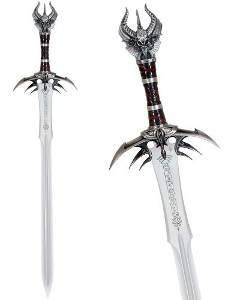Difference between revisions of "Tarvitz Family/Saul"
Malevolent (talk | contribs) (Completed "The Forging of the Blade" section.) |
Malevolent (talk | contribs) m (Change of headers) |
||
| Line 21: | Line 21: | ||
For his final addition to the sword; Saul inscribed the name of the weapon, Dagnir Rauko, onto the blade, just above the hilt. Dagnir Rauko is literally translated as Bane Daimon, however in the common tongue it would be called Daimon's Bane. | For his final addition to the sword; Saul inscribed the name of the weapon, Dagnir Rauko, onto the blade, just above the hilt. Dagnir Rauko is literally translated as Bane Daimon, however in the common tongue it would be called Daimon's Bane. | ||
| + | ====The Test of Courage==== | ||
| − | === | + | ===Dwilight=== |
| − | ===The | + | ====Arrival==== |
| + | ====Lordship==== | ||
| + | ====The Crusades==== | ||
Revision as of 04:27, 14 September 2011
|
Error: No contents found at URL https://battlemaster.org/data/character.php?World=8&Name=Saul.
Error: No contents found at URL https://battlemaster.org/data/character.php?World=8&Name=Saul.
Contents
History
Growing Up
Being the first born of House Tarvitz, Saul enjoyed a lot of comforts that others of his family would not share in.
The Trials
The Forging of the Blade
Saul studied for a large majority of his life in forgery in order to be able to forge a sword that was worthy of passing this trial. Under the eye of the master blacksmith, Saul Tarvitz learnt the tools of the trade; how to fold the metal, shape it, hammer it, and most importantly, shape it into what he wanted; it took months for Saul to master the basics of forgery, and that was only the beginning. As soon as he had mastered the basics, he moved onto the more important parts; the detail. To Saul, a sword without detail, was a sword without a soul.
The day after his 16th Birthday, Saul went into the forgery and locked the doors. This was the sign to show that he was not receiving help, nor was he to leave until he had completed the task which he had begun. To begin with, he had to decide upon what shape he wanted his sword to take and what blade he wished it to be. Making the actions he had practised during sword fighting, he decided upon two . Upon deciding upon the type of sword that he wished for, Saul then took into account the style of the pommel, hilt and cross guard. He wanted it to be something unusual, something unique that would stand out on the wall of his estate. He thought long and hard about the design of this, and eventually came up with design that he would create for his weapon.
Setting to work on the blade, Saul prided himself in the folding of the steel that he used; working it day and night he folded the steel 7 times over before beginning to forge the blade, this ensured that the steel was of the highest quality and less likely to break, or become dull during combat. Upon finishing the blade, Saul set to work on the hilt and the guard; knowing that the blade was not the only part of a sword that could be used, he wanted the cross guard to not only be a guard, but also a weapon in it's own right. Taking that, and the design for the pommel that he had decided upon, he fashioned 3 steel looking wings that not only acted as a defence against blows that might strike his hand, but as a weapon to slice the throat of an opponent. For the handle of the blade, Saul took a dark wood, and polished it up, fitting it to the rod in segments such that it was not as one solid piece. As his second to last act, Saul started work on the pommel of the sword. He had decided upon a Daimon looking figure, an ironic symbol of what the sword was actually to be used for. Using images and descriptions that he had heard and been told, he fashioned a skull with horns -which he sharpened- and set into work detailing them as best as he could.
For his final addition to the sword; Saul inscribed the name of the weapon, Dagnir Rauko, onto the blade, just above the hilt. Dagnir Rauko is literally translated as Bane Daimon, however in the common tongue it would be called Daimon's Bane.
